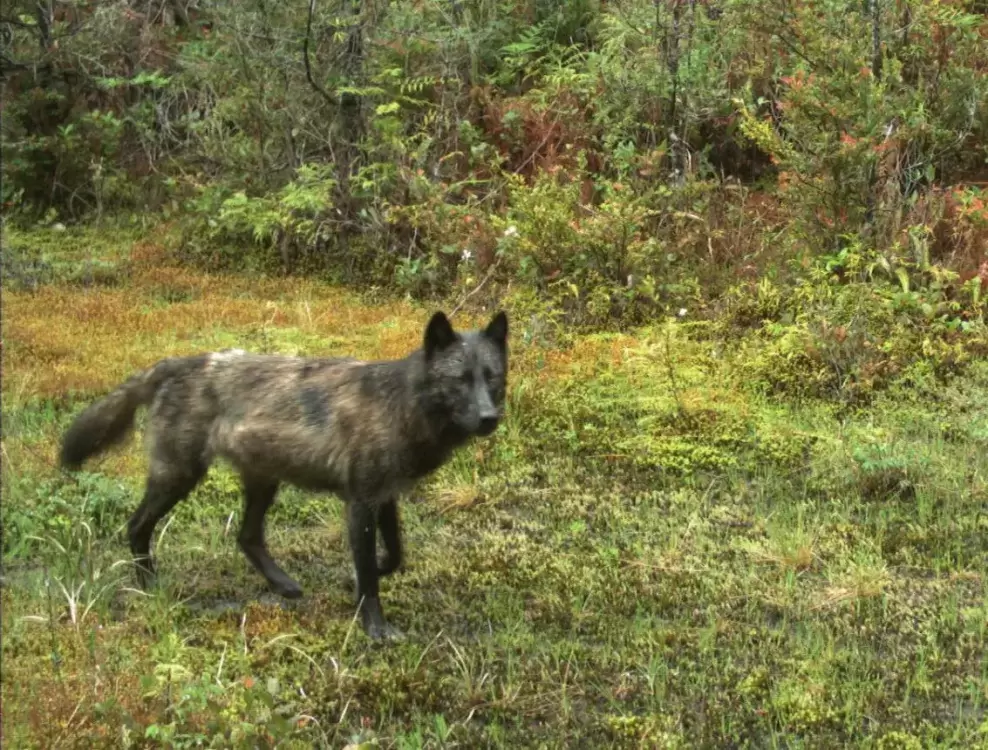A newly arrived pack of wolves on the Esowista Peninsula has raised the concern of Parks Canada officials after reports of the animals’ unusual behavior were received.
The pack of five wolves has been observed resting in an open area. This is unusual because wolves, normally a secretive animal, prefer to take cover in the forest. Some people are worried that these wolves have interacted with humans and are becoming habituated.
Habituated wolves are ones that have lost their natural fear of humans. This can happen when people feed or linger near wolves in order to observe them or to take a close-up picture.
Habituated wolves may become easy prey for hunters. While they are safe from hunters within park boundaries, once they cross those invisible lines they are fair game. Outside Parks Canada boundaries a hunter may kill up to three wolves during open season on Vancouver Island.
Food conditioned animals are ones that have been introduced to a non-natural food source like a trash dumpster, picnic sites or any place human food has been left. Bears and wolves are scavengers and are susceptible to becoming food-conditioned.
People who work with wildlife warn people against feeding, enticing or approaching wild animals because it teaches the animal life-threatening lessons. Losing fear of humans rarely ends well for wildlife.
Any habituated animal may be rehabilitated before harm comes to humans. Those are the lucky ones.
Food conditioned animals will not be so lucky.
“When an animal gets a food reward, that lesson proves to be a strong one,” said Arlene Armstrong of Pacific Rim National Park Reserve. “We find that they will often never unlearn that behaviour, and may even train their young to adopt the same behavior,” Armstrong explained.
There was a time when attempts were made to trap and relocate food-conditioned animals, but the practise has been abandoned. Armstrong said the forest is a complex society of wildlife, and moving one animal into another’s territory hasn’t been effective.
Bears often find their way back to their familiar food source. Sadly, when wildlife officers hear the words food-conditioned wolf or bear, they get out the shotguns.
Parks Canada is concentrating their wildlife protection efforts on educating the public. Popular animal television programs and things of that nature show brilliant close-ups of wild animals, which may fool people into thinking it is safe to approach animals to take their own close-up wildlife photographs.
“If you can fill your iPhone screen with a wild animal then you are too close to the animal,” she warns. What people don’t understand, she continued, is photographers have huge lenses and don’t get close to wild animals.
Most locals know that they share their beautiful west coast home with bears, cougars and wolves and they follow mutually respectful rules in order to live in harmony.
That includes keeping their distance from wildlife, never feeding them and keeping attractants away.
“The fact that a new wolf pack is here is something we welcome and take great pride in,” Armstrong told Ha-Shilth-Sa.
Parks Canada, along with the local Tla-o-qui-aht First Nation, has a great amount of respect for wolves and other wildlife. They welcome these animals in the park and in Tla-o-qui-aht territories. The two entities have overlapping boundaries.
But Parks staff are concerned about the new pack. “These animals don’t exhibit the wariness to people or to vehicles that they should and we worry that people will take that as a signal to engage the animals,” Armstrong said.
To feed them, approach them too closely or lure them to your vehicle does not leave a positive legacy for the animal, she explained. When people do that they reinforce to the animal that it’s okay to approach people and that’s not a good message for the animal to learn.
When wolves or any other wild animals scare humans with their behaviour, humans don’t tolerate that well and the wild animal pays the price for our choices, Armstrong explained.
Parks Canada monitors wildlife with remote motion-activated game cameras, and through tracking programs conducted by wildlife biologists. They will close trails and beach parking lots in an effort to protect both the wild animals and humans if required.
“People may think we close the beach parking lots at night to keep partiers out but we do it to allow the wildlife safe access to the beach,” said Armstrong. These large animals are active all day, but particularly at dawn and after dusk, and the beaches are prime travel corridors.
“They give us the beach during the daylight hours and we return the favour by protecting it for them at night,” said Armstrong.
Parks Canada is working with other agencies, including Tla-o-qui-aht Tribal Parks, on developing a regional wildlife reporting system.
Armstrong hopes people will call and report sightings of wildlife in the park so that they can keep tabs on where the animals are and take precautions where necessary.
“In the past there’s been fear that if you see an animal and report it, the animal will be killed,” said Armstrong. The truth is that reports of animal sightings are used to help Parks staff monitor the wildlife and manage the visitors. “It helps us give out better messaging,” she said.
Bears, for example, may be feeding on berries near hiking trails; if someone reports a sighting, Parks staff may close the trails to the public.
If there is a cougar sighting, an advisory notice may be posted at the trail head, and on the Parks websites.
“These animals are always here; there’s no magic formula where we can predict where they will be,” said Armstrong. These animals live here all year round and they do not hibernate.
If you spot bears, wolves or cougars in the area between Tofino and Ucluelet call Parks Canada at 250-726-3500 or call the provincial wildlife number at 1-877-952-7277 for any animals spotted outside the park boundary.







